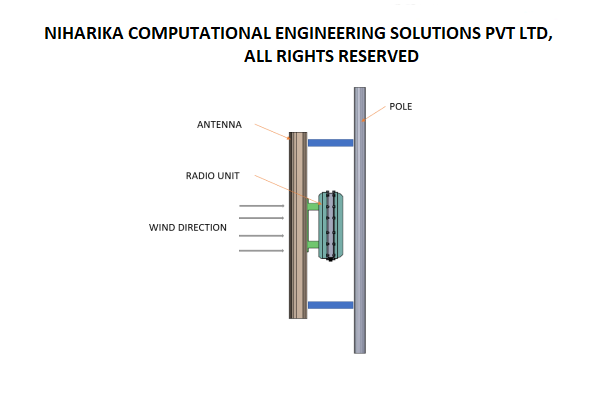PROJECT DETAILS
FADEC is a computer-managed aircraft ignition and engine control system used in modern commercial and military aircraft to control all aspects of engine performance digitally. Our client is a Government of India-approved Aerospace and Defense R&D unit. The client is developing FADEC for Defence Research and Development Organization (DRDO), Ministry of Defence, Government of India. We collaborated with the client from the initial stages of the design process. Our domain expertise leveraged with Computational Fluid Dynamics simulation (CFD analysis) technology has accelerated our clients Innovation process and enabled our client to explore more design options and make well-informed decisions at the appropriate stages in the product development cycle
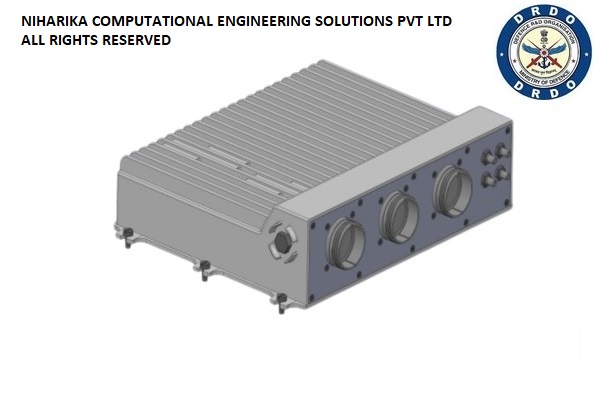
The 3D CAD model provided by the client has been simplified to meet the requirements of the CFD analysis. This simplification takes into account the pertinent physics and the quality of the mesh.
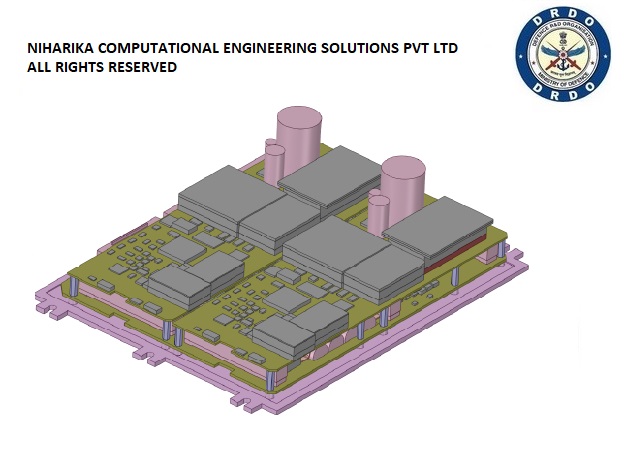
The CFD mesh has been created based on the simplified CAD model discussed previously. This mesh is composed of polyhedral hex core elements, ensuring adequate resolution in areas with high gradients. The total cell count of the mesh is 8 million, achieving optimal quality metrics in accordance with established CFD analysis standards.
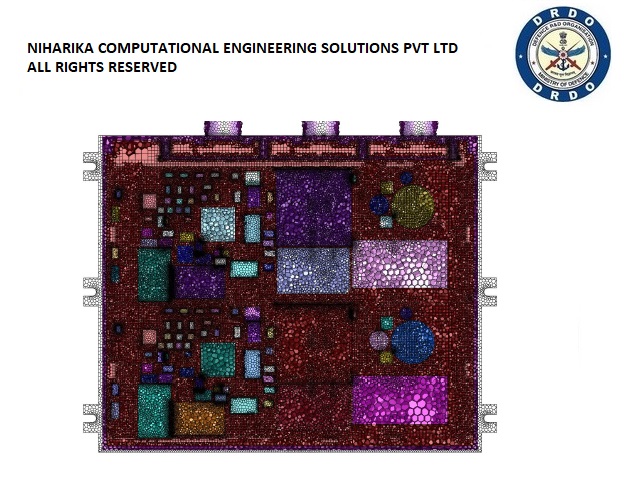
CFD analysis is performed at ambient temperatures of 40 degrees Celsius and 75 degrees Celsius. Various operational sequences of ECU units are evaluated in the CFD analysis to comprehensively assess the effectiveness of the thermal design. All heat-dissipating components are represented as 3D models with volumetric heat dissipation characteristics. Junction contact resistances are incorporated according to the specifications provided by the manufacturers data sheets. The enclosures radiation is modeled using a surface-to-surface radiation approach. Overall, the CFD analysis is conducted with great attention to detail, adhering to the best practices in electronic cooling CFD analysis. Our rigorous CFD methodologies have produced results that align 98% with the measured values.
CFD analysis has been conducted for the entire operational sequence of ECU units. The results of the CFD analysis indicate that the junction temperature of all dissipating equipment remains within the limits specified by the manufacturer, and there is an adequate operational margin. Additionally, no thermal hot spots have been detected, suggesting that the overall thermal configuration is highly effective.
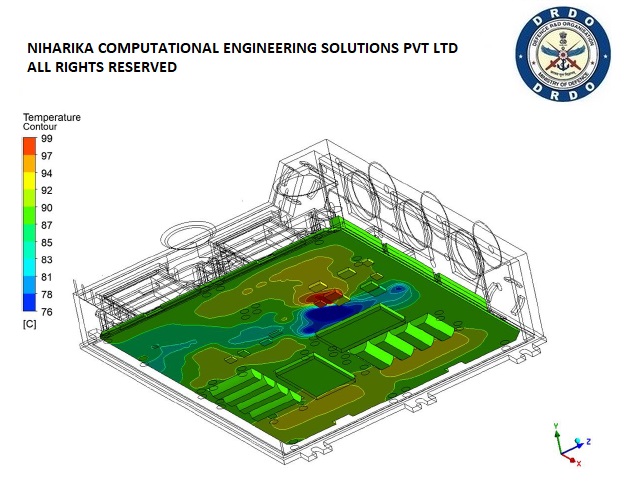
The results of the CFD analysis indicate that the thermal design of the FADEC unit is highly effective. This design promotes safer operating temperatures for all electronic components housed within the enclosure, thereby enhancing overall reliability.
We Got More
Go through All Our Case Studies
CFD analysis of Rotary Vacuum Brazing Furnace-RVBF
RVBF is an Inert gas-circulated, closed-loop Integrated thermal system with operating temperatures up to 1500 Deg Celsius. The Integrated thermal loop consists of a heat treatment chamber, a centrifugal blower for gas circulation, Shell and Tube Heat exchanger to achieve gas cooling, and an Electromagnetic Induction heater to reach a higher operating temperature. Controlled cooling of the job is essential to achieve the desired metallurgical structure after heat treatment. Niharika Computational Engineering Solutions Pvt Ltd (NCES) has collaborated with the client and analyzed the overall thermal performance of RVBF. We conducted transient Computational Fluid Dynamics (CFD) analysis to analyze the cooling of the job during the cooling cycle. Our CFD analysis process is validated with the help of experimental data obtained from the existing RVBF unit, which is of slightly lower capacity. Read More
Thermal and structural analysis of Chemical Vapor Infiltration and Chemical Vapor Deposition furnace
CVI and CVD is a thermo-vacuum chamber operating up to 2500 Degree Celsius. CVI-CVD furnace is mainly to mold high-temperature sustainable composites used in supersonic missiles. This Thermo-vacuum facility is commissioned at DRDL- Hyderabad, the Defence Research and Development Organization (DRDO) propulsion complex, Ministry of Defence, Government of India. The electromagnetic Induction heater is used to generate higher operating temperatures of the order of 2500 Degree Celsius. Niharika Computational Engineering Solutions Pvt Ltd (NCES) has collaborated with the client and conducted Computational Fluid Dynamics (CFD) analysis to assess the thermal performance of the furnace. We also conducted structural analysis (FEA) to predict the thermal expansion of the plunger unit. Read More
FEM analysis for Telemetry Flight Test Instrumentation
PCAMI-1000 is an Airborne ruggedized Instrumentation System that handles excitation, attenuation, signal conditioning, data, embedded video and audio acquisition, encoding, operating numerous buses such as MIL 1553 and Arinc, and onboard data recording and data transmission with chassis of varied slot capacities such as 3, 6, 9 and 13 slots. Read More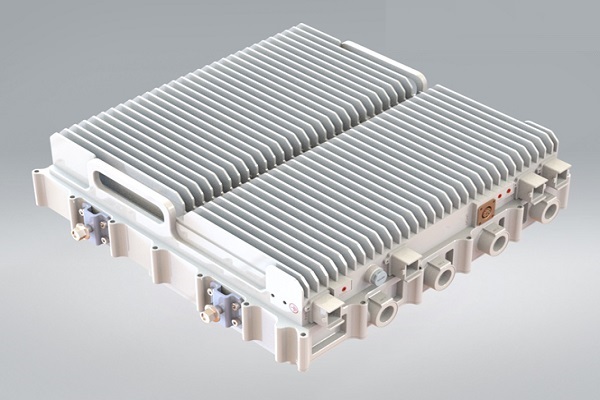
CFD analysis of Multi Band Remote Radio Unit
The advent of 5G technology has brought about unprecedented advancements in wireless communications, enabling faster speeds, lower latency, and increased capacity. These advancements are associated with higher power consumption and increased heat generation in the 5G Remote Radio units.Increasing data rates and network densification require radio units to process larger volumes of data, leading to higher power consumption and heat generation. Environmental factors such as ambient temperature, humidity, and exposure to direct sunlight also impact the thermal aspects of the radio units. Read More